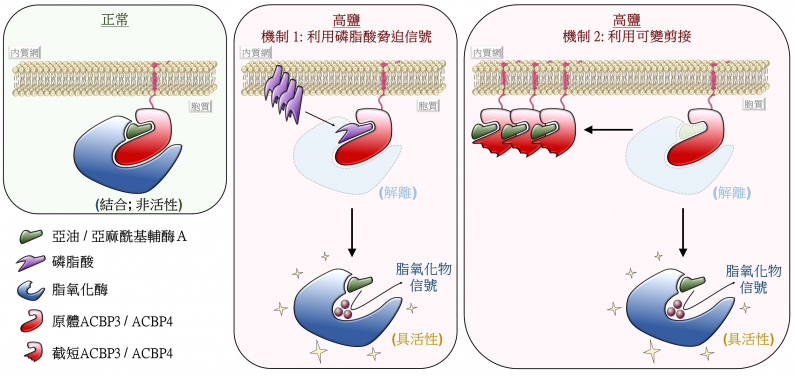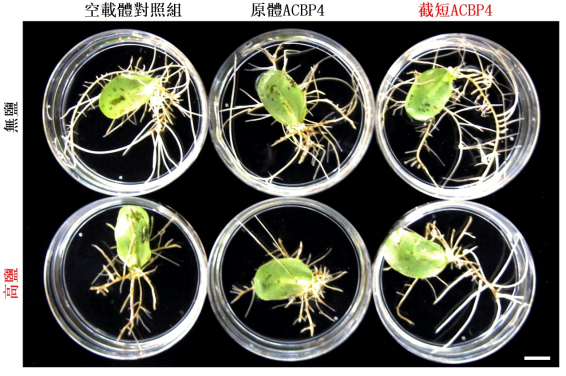港大揭示大豆適應鹽土的啟動機制 有望提高農業生產
2022年01月12日

圖3:ACBP3及ACBP4調控高鹽環境下脂氧化物信號形成的示意圖。
在正常條件下,原體ACBP3/ACBP4與亞油/亞麻酰基輔酶A及脂氧化酶結合,使其失去活性(左圖)。在高鹽逆境下,複合體在雙重機制調控下解離。其一,酰基輔酶A在磷脂酸信號的競爭下與ACBP3/ACBP4解離(中圖)。其二,mRNA前體通過可變剪接,產生不能與脂氧化酶結合的截短ACBP3/ACBP4變體(右圖)。因此,被激活後的脂氧化酶產生脂氧化物信號,誘發適應性反應。

Figure 1. Overexpression of truncated ACBP4 variant promotes salt tolerance in soybean hairy roots. Soybean hairy roots overexpressing the native (bottom middle) and truncated (bottom right) forms of ACBP4 were more salt-sensitive and salt-tolerant than the vector-transformed control (bottom left), respectively. Under normal conditions, the hairy roots of all genotypes grew similarly (top panels). Scale bar = 1 cm.

圖1:截短ACBP4變體在大豆毛狀根的超表達提高耐鹽性。
原體 (上列中)和截短(下列右)ACBP4在大豆毛狀根超表達時,相比對照組(下列左)分別減少和提高耐鹽性。在正常條件下,所有基因型生長無異(上列)。比例尺 = 1公分。

Figure 2. Overexpression of truncated ACBP3 variants promotes salt tolerance in Arabidopsis. Transgenic Arabidopsis overexpressing the native Class II ACBPs and truncated ACBP3 variants were more salt-sensitive and salt-tolerant than the vector-transformed control, respectively. Scale bar = 1 cm.

Figure 3. Model for ACBP3/ACBP4-regulated generation of oxylipin signals during the salinity response. Under normal conditions, ACBP binding with acyl-CoAs (C18:2 and C18:3-CoAs) facilitates sequestration of an inactive lipoxygenase. High salinity triggers dissociation of this complex by a dual mechanism. First, phosphatidic acid signals compete with acyl-CoAs for ACBP binding. Second, pre-mRNAs are cut and rejoined in an unusual way (known as alternative splicing) to produce ACBP variants lacking the lipoxygenase-interacting domain. Thus, the lipoxygenase is activated to generate oxylipin signals for adaptive responses.

圖3:ACBP3及ACBP4調控高鹽環境下脂氧化物信號形成的示意圖。
在正常條件下,原體ACBP3/ACBP4與亞油/亞麻酰基輔酶A及脂氧化酶結合,使其失去活性(左圖)。在高鹽逆境下,複合體在雙重機制調控下解離。其一,酰基輔酶A在磷脂酸信號的競爭下與ACBP3/ACBP4解離(中圖)。其二,mRNA前體通過可變剪接,產生不能與脂氧化酶結合的截短ACBP3/ACBP4變體(右圖)。因此,被激活後的脂氧化酶產生脂氧化物信號,誘發適應性反應。

Figure 1. Overexpression of truncated ACBP4 variant promotes salt tolerance in soybean hairy roots. Soybean hairy roots overexpressing the native (bottom middle) and truncated (bottom right) forms of ACBP4 were more salt-sensitive and salt-tolerant than the vector-transformed control (bottom left), respectively. Under normal conditions, the hairy roots of all genotypes grew similarly (top panels). Scale bar = 1 cm.
- 1 / 6
- 2 / 6
- 3 / 6
- 4 / 6
- 5 / 6
- 6 / 6
氣候變化引致海水上漲、旱區擴張和地下水耗減,因而增加農地的含鹽量。不當的耕作方式亦催化了土壤鹽化的危機,損害農作物的產量,威脅全球肌餓人口。因此,科學家正開拓有助植物抗鹽的技術,以保障世界糧食安全。
香港大學(港大)生物科學學院黃乾利辛烱僖基金教授(植物生物技術學)蔡美蓮教授與研究助理教授龍兆章博士,揭示了大豆啟動高鹽適應性變化的分子機制,有望提供解決鹽土問題的方法。這項新發現已於植物學權威期刊 《植物細胞》(The Plant Cell)發表,研究成果將有助開拓抗鹽植物的新策略。
背景
在高鹽環境下,固著不動的植物透過自身的迅速反應求存,當中包括改變根部結構、產生離子泵和製造特定代謝物等等。這個適應性過程涉及多個逆境信號,包括兩類重要脂質 - 磷脂酸(Phosphatidic acid)和脂氧化物(Oxylipins)。蔡教授的研究團隊早前發現,II類酰基輔酶A 結合蛋白(ACBP)能促進磷脂酸形成。ACBP家族成員在真核生物中高度保守,能結合酰基輔酶A(Acyl-CoA),即激活形式的脂肪酸;而脂氧化物是不飽和脂肪酸氧化成的衍生物,生物學者對激活其生成的過程及其與磷脂酸之間的串擾作用向來知之甚少。
關鍵成果
蔡教授的研究團隊意外地發現,大豆根經鹽液處理的數小時內,產生比原體II類ACBP3及ACBP4更小的截短蛋白。蔡教授說:「它們經mRNA前體被異常剪接而成。這現象從没出現於植物ACBP研究中,可幸這次我們抓對時機。」
團隊表示,ACBP4的原體和截短蛋白在大豆毛狀根超表達時,相比對照組分別減少和提高耐鹽性(見圖1)。擬南芥轉基因試驗亦得出相似結論,即ACBP3截短蛋白的超表達株系比對照組更耐鹽,原體ACBP3及ACBP4超表達株系則更敏感(見圖2)。顯微鏡、分子及生化分析進而得出一個模型(見圖3),闡明ACBP3和ACBP4啟動脂氧化物信號形成的機理作用,以及脂氧化物和磷脂酸信號的串擾。蔡教授簡述道:「脂氧化物由脂氧化酶催化而成。在一般情況下,此酶與ACBP及酰基輔酶A可逆性結合時失去活性。在高鹽逆境下,複合體受到磷脂酸和ACBP截短蛋白的競爭性抑制而解離,並激活脂氧化酶。」
蔡教授期望揭開脂氧化物信號傳遞機理的其他元素,並嘗試利用基因工程改良大豆和其他作物的耐鹽性。科創成果或能減少鹽土對作物收成的損害,在氣候變遷的影響下提高糧食供應。蔡教授表示,對獲頒黃乾利辛烱僖基金教授席感到榮幸,希望藉推動植物生物技術的應用,以確保糧食供應並締造可持續的未來。
研究團隊
項目由香港大學生物科學學院黃乾利辛烱僖基金教授 (植物生物技術學) 蔡美蓮教授帶領,與香港中文大學卓敏生命科學教授兼農業生物技術國家重點實驗室主任林漢明教授合作研究。港大生物科學學院研究助理教授龍兆章博士為期刊論文的第一及共同通訊作者,其他參與研究的港大學者包括賴思涵小姐、王海洋博士、張秀英小姐、劉艾林博士及郭澤華博士。
研究項目獲黃乾利辛烱僖基金、香港研究資助局卓越學科領域計劃(AoE/M-403/16)及創新科技署創新科技基金(國家重點實驗室計劃農業生物技術國家重點實驗室)資助完成。
論文連結:
“Oxylipin signaling in salt-stressed soybean is modulated by ligand-dependent interaction of Class II acyl-CoA-binding proteins with lipoxygenase” by Shiu-Cheung Lung, Sze Han Lai, Haiyang Wang, Xiuying Zhang, Ailin Liu, Ze-Hua Guo, Hon-Ming Lam and Mee-Len Chye 《植物細胞》全文連結網址: https://doi.org/10.1093/plcell/koab306
有關黃乾利辛烱僖基金教授席(植物生物技術學)之詳情,請瀏覽:
https://www.daao.hku.hk/ephku/en/Professorship-Detail/27-Wilson-And-Amelia-Wong-Professorship-In-Plant-Biotechnology.html
圖片下載: https://www.scifac.hku.hk/press
傳媒如有查詢,請聯絡港大理學院外務主任杜之樺 (電話:3917 4948;電郵:caseyto@hku.hk ) 或助理傳訊總監陳詩廸(電話:3917 5286;電郵:cindycst@hku.hk)。

